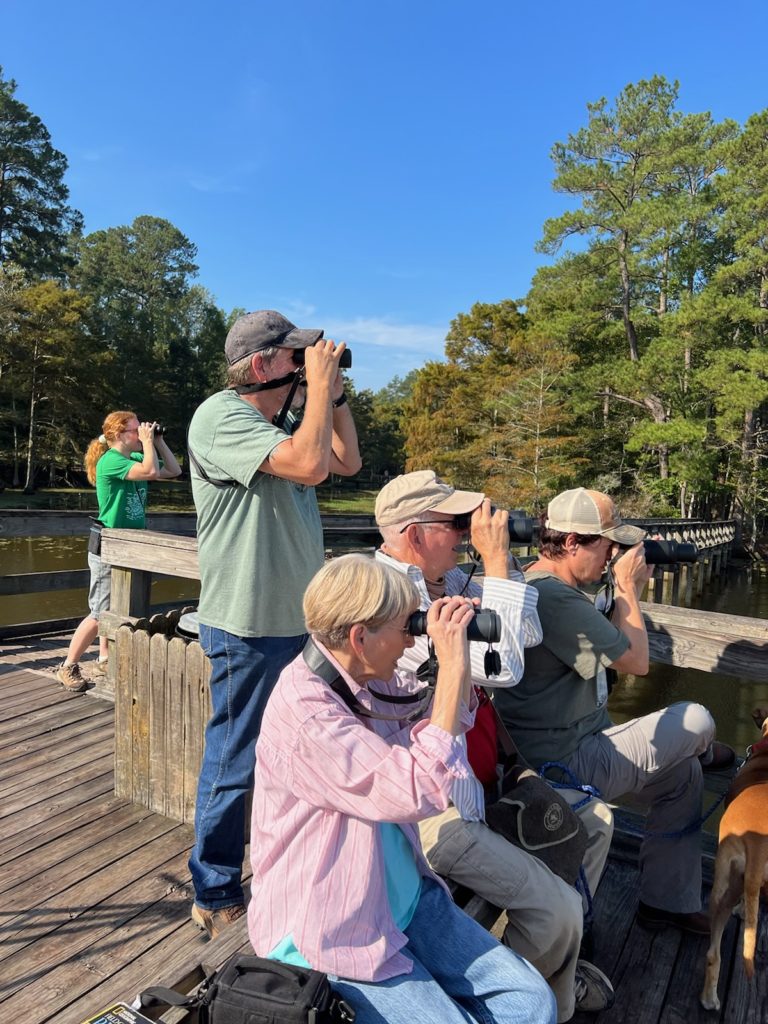Our expert birders, Fred Lyons and Philip Hight, lead a birding group every 2nd Saturday of the month at Martin Dies Jr. State Park. The bird species vary depending on the time of year. I went birding with them on October 9th, and we had a pretty good show!
I set out at 8:00am with my hand-me-down binoculars and a simple point-and-shoot camera. The day started out with a Great Blue Heron, Downy Woodpecker, and a female Yellow Warbler sighting at the Cherokee Unit. Little spiderwebs were scattered between the blades of grass as we walked to the water’s edge. They glistened in the early morning sunlight. By 10:00am, we had joined Ranger Amy at the observation bridge at the Walnut Ridge Unit. Memorable events happened here! While sitting on the bench at the observation bridge, facing out toward the lake, an Osprey flew right into our field of view and dove for a fish! Just as perfect as if we had paid to see a show in a theater. Shortly after, a Belted Kingfisher flew in a circle around us, giving us ample opportunity to identify its gender. It was a female. It was joined by a second kingfisher (gender unknown), and they could be seen and heard squabbling in the cove – possibly fighting over territory. Across the lake, just above the flowering water lilies, Double-Crested Cormorants were flying. A white, crane-like bird stood in the water to hunt for fish, but it was far enough away that we were unable to identify it even when using Philip’s spotting scope. Amy thought it might have been a White Ibis, but Philip disagreed, thinking instead that it was a Snowy Egret. Identifying by sight can be a challenge! The Osprey went fishing a second time, much farther away, and caught a bigger fish! One of the group remarked that he was eating well that day.
Ranger Amy was kind enough to take this photo while we were viewing a kingfisher.

I came away from the trip with new knowledge! This had been my first time birding with a guide. I learned that to quickly find a bird’s location with your binoculars, you start by looking at the bird and then bringing the binoculars up to your eyes without moving your head. This allows you to spot the bird quickly before it moves to another tree branch. I also expanded a little on my existing knowledge. I knew that the SFASU forestry students studied songbirds for one week of their summer field station. As an environmental science student, I did not go, but I learned a few tricks from them. They told me that there are short, catchy phrases that one can memorize, that stick in your head like a jingle. For example, Chuck-Wills-Widow says his own name and White-Eyed Vireo says, “Quick! Bring me a beer! Quick!” I have spent years wondering how to find out more phrases for more birds. Today, the birding group told me that these are called mnemonics – based on a Greek word for memory. I find it to be the easiest way to remember bird songs.
Mnemonics vary, and there are many suggested phrases. Here is a link to a useful list: http://birding-world.com/using-bird-song-mnemonics/
Gear: Ranger Amy gave us booklets with a field checklist, specifically made for Martin Dies Jr. State Park. I checked off 6 different species in three hours! My binoculars got plenty of use too, even my 7×35 did the job, though others in the group recommended a much stronger magnification and many prefer the Nikon brand. I didn’t get to use my point-and-shoot camera for birds; you need a better-quality camera with a telephoto lens for that. However, I did get pictures of the wonderful people who made this trip a learning adventure!
The morning I arrived to go birding my attitude was that birding was boring, however, I needed to learn in order to manage for songbirds on my parents’ land. By the end, I was excited enough to run home and type out this article. I definitely recommend joining the group, even if you aren’t really into birding, and pick up one of those checklists from Headquarters. It was a lot of fun!




